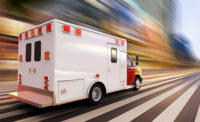8 workplace safety considerations every new business owner should consider

If you’re starting your own business, then safety should be one of the top things on your mind when you begin hiring employees. A bad incident can result in expensive fines, rising workers’ compensation costs and damage to your reputation. And those are just the direct business costs. The human and indirect costs of workplace injury are harder to quantify but no less important.
To help you prevent incidents that could potentially cost your business thousands of dollars and months of lost productivity, here are eight proven ways to protect employees as your company grows.
1) Perform a job hazard analysis
Whether you’re opening a grocery store or a mining operation, you need to have a clear understanding of on-the-job risks. That’s where the Job Hazard Analysis comes in. When trying to implement a workplace safety program, this risk analysis should be step one.
A Job Hazard Analysis isn't just a document, it's a process. By carefully documenting all of the known risks associated with every task performed by your workers, you can then carefully plan on the best ways to reduce these risks to your workers. The end result should be a JHA document, which according to OSHA should focus on the "relationship between the worker, the task, the tools, and the work environment." Your Job Hazard Analysis document should not only include a list of all potential hazards, but it should also identify the training your employees will need to manage these hazards safely.
Start by creating a list of every job or duty that will be performed in your workplace. Then carefully document every likely hazard employees will face in performing those duties. This will give you an itemized list of all the necessary training you will need to provide in order to ensure the safest possible work environment.
2) Regular practice enforces safe habits
Repeated safety drills and presentations may get a little tiresome and tedious but repetition leads to habit. Running your employees through simulated scenarios like a spill, a trip hazard, a gas leak and other risky situations will help improve their reactions if those problems ever come to pass. When the worst does happen, they will know immediately how to act. Remember, a knowledgeable employee is a safe employee.
However, not all safety training should be pre-planned. When a supervisor witnesses an unsafe behavior or accident, he or she should immediately respond. This allows managers to turn unsafe behavior into teachable moments.
Not only will repeated safety training help protect your team, they can also save you money in the long-term.
3) Enforce the rules of reporting
The adage, “If you see something, say something,” is a great motto for workplace safety. Unfortunately, workers who come from toxic work environments may believe that they will get in trouble for reporting dangerous working conditions to their employers. That’s why it’s so important to teach employees to promptly report all hazards, or potential hazards, to management.
For instance, if anyone shows up to work showing signs of intoxication, employees should know exactly whom to report their concerns to and how to do so quickly. They should understand that their reporting will be kept confidential and there won’t be any retaliation allowed on them for sharing this information. Your employees should be able to trust that management takes workplace safety issues seriously.
As a business owner or manager, you can’t do your job if you are not aware of the dangers present so it’s very important your team feels comfortable coming to you with potential issues before they become emergencies.
4) Provide personal protective equipment
Although it may seem counterintuitive to an outsider, providing Personal Protective Equipment (PPE) is actually considered to be the "least effective" component within the workplace safety hierarchy of controls.
The hierarchy of controls includes five methods for protecting workers, and it is often portrayed as an inverted pyramid, with the most effective methods at the top and the least effective at the bottom. In order of importance, the hierarchy of controls includes eliminating the hazard, replacing the hazard, engineering controls to isolate workers from the hazard, and administrative controls to change the way dangerous work is performed. The hierarchy places safety equipment at the very bottom.
Of course, that doesn't mean PPE isn't important; in fact, it's essential. Safety equipment is a must-have in many workplace environments, including manufacturing and construction. What type of safety equipment you need will vary depending on the job itself but it can include items such as high-visibility clothing, fall-protection gear and specific footwear. Some examples of the most common safety equipment are:
- hard hats
- earplugs
- gloves
- goggles
- high-visibility rain jackets
- gas-detection equipment
- fire extinguishers
Of course, it’s not enough to provide the right safety equipment for the job. You must also ensure that every employee on your team is properly trained on how to properly use this equipment. The world’s best fall protection slings are useless if they aren’t used correctly.
5) Lead by example
Make sure that your managers are always wearing and using the proper equipment whenever venturing into a hazardous area. Employees really will take their cues from their team leaders, which is why leading by example is a great way to make sure your employees stay safety compliant. If your employees see managers ignoring safety requirements, they soon will too.
6) Reward safety awareness
Things like small gifts for outstanding workplace safety can encourage your employees to be more vigilant and dedicated to keeping themselves, their co-workers and their place of employment safe. A great goal to shoot for is a zero-incident workplace. Employees and teams who maintain such a stellar environment for a certain period of time should be recognized for their hard work. This can be something as simple as a team lunch or a gift card. These rewards don’t have to be given all the time but doing something on occasion can be a good source of encouragement.
A rewards system can be a double-edged sword, however, as rewarding employees too often or placing too much emphasis on the reward can cause them to avoid reporting injuries or accidents in order to keep their “days without incident” counts high. Be sure to heavily encourage that all employees still report all incidents to management.
7) Think long-term
Unfortunately, when preparing for workplace safety hazards, too many people ignore the long-term risks that come with certain lines of work. Let’s take transportation as an example. While on-the-road safety might seem like the most immediate concern, there are other hazards to consider. A sedentary lifestyle poses its own health risks, and drivers may have to leave their job if they aren’t taking care of their overall health.
In addition to immediate, day-to-day safety risks, don’t forget to consider the long-term and stress-related injuries that can cause missed days, lost productivity and high turnover. By offering a few wellness perks, such as gym memberships, healthy food onsite and paid days off, you can encourage a lifestyle of health and safety that transfers over into their daily job.
8) Ensure that breaks are taken
A large amount of workplace-related injuries happen because employees are tired and not paying attention to their surroundings. The best way to counter that is to keep employees energized, focused and well-rested. Make sure that all employees take their regular breaks, especially in labor-intensive work environments. Skipping breaks may increase productivity, temporarily, but a single accident due to exhaustion or inattention could mean a much larger loss. If your company uses heavy equipment or other dangerous machines, it could even mean a loss of life.
However, as the U.S. workforce has migrated from the factory floor to the office, many companies have embraced the concept of "microbreaks." While parking yourself in front of a computer might not seem as hazardous as operating heavy equipment, this workstyle poses its own risks. Microbreaks allow office workers to take frequent, brief breaks from their work that help minimize the risks of a sedentary job.
Following these tips for creating a workplace safety program will help get your company on the right path to sustainable growth. If you want to avoid any accidents that might hurt your company’s future, then you have to take a proactive approach to workplace safety.
This guest post was contributed by Transportation Safety Apparel.
Looking for a reprint of this article?
From high-res PDFs to custom plaques, order your copy today!









